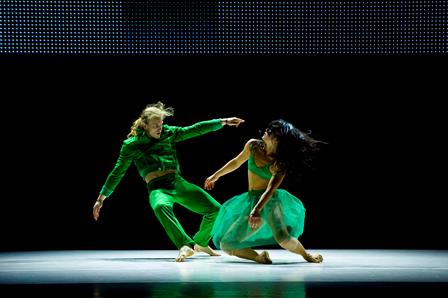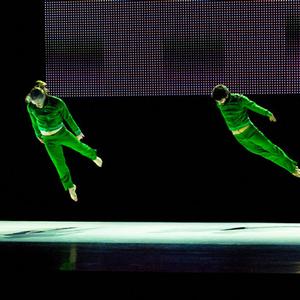13 June 2013, Canberra Theatre

Garry Stewart’s G had a short run in Canberra last week. Although it first had a showing in 2008, this was my first opportunity to see it and once again I was impressed by Stewart’s exceptional approach, which combines his unique intellect with his emphasis on the physical. My review was published in The Canberra Times on 15 June 2013 and is reproduced below.
‘G is Garry Stewart’s deconstruction of Giselle made for the company Stewart directs, the Adelaide-based Australian Dance Theatre. But although G refers back to a ballet made in the 19th century, there are no happy, smiling peasants in pretty matching outfits celebrating harvest time, and no lines of ghostly Wilis dancing in the moonlight. Instead Stewart gives us a no-holds-barred examination of states of being that the traditional Giselle hints at but never blatantly puts before our eyes.
Stewart condenses the narrative and the story unfolds before us in words on an LED screen. Each of the main characters is known by the initial of his or her name. We read of the betrayal of G (Giselle) by A (Albrecht), a prince disguised as L (Loys) but who is really betrothed to a princess B (Bathilde, and the subsequent death of G and her entry into a spirit world of Wilis headed by M (Myrtha).
Props play a part in making the narrative clear. A sword, the weapon by which G dies, is used at various points, B and her party arrive wearing crowns to signify their royal status, and some dancers are carried, stiff and lifeless, across the stage wearing shrouds to represent the Wilis who have risen from their graves. Elements of the traditional Giselle are there.
But what really drives G is Stewart’s research into illness, hysteria, suicide and the inter-connectedness that was believed to exist between madness and sex at the time Giselle was created in 1841. It is largely a look at the state of mind of Giselle, the woman, rather than a story of love and betrayal. The dancers’ movements are often flagrantly sexual or irrationally repetitive. The work moves from left to right across the stage, unchanging and inexorable in direction but constantly changing in rhythm and intensity. Sometimes the dancers walk slowly and purposefully, sometimes they cross the stage with fast moving feet. Sometimes the movement looks quite classical but is soon followed by sequences where the dancers hurl themselves through the air in displays of extreme dancing.
There are, nevertheless, a number of references to traditional productions of Giselle, enough for audiences to make the link if they wish. Some such references are choreographic. Two dancers often partner each other with arms linked, imitating the steps Giselle and Albrecht perform in Act I of traditional versions, and dancers often walk across the stage with arms crossed over their chests, palms facing upwards in the pose that is characteristic of the Wilis in Act II. In addition, the electronic score by Luke Smiles includes a brief section taken from the 1841 score for Giselle by Adolphe Adam. And some more props remind us of the traditional Giselle, including a daisy held by one dancer as she crosses the stage towards the end of the work. It harks back to the ’he loves me, he loves me not’ game played by Albrecht and Giselle in Act I of traditional productions.
The physicality of the dancers of Australian Dance Theatre has become legendary and they certainly show their thrilling athleticism in G. But what is also admirable is the way in which they show the madness, the hysteria and the unstable, manic qualities that Stewart is seeking. Shaking hands, nodding heads, wildly flailing limbs, crazed eyes, they are all there and all electrifying to watch.

At its best, the traditional Giselle is a moving work leaving us to ponder, perhaps a little loftily, on many aspects of love, loss, betrayal and grief. Most of those who stage it look to the notions of Romanticism in the arts for their inspiration. Stewart’s G is clearly of today: there is nothing of the 19th-century Romanticism about it. But what makes it such a compelling work is that it makes new art from an old work without destroying the old and without compromising Stewart’s constant push towards the new.’
Michelle Potter, 17 June 2013
I had previously spoken briefly to Stewart about his interest in an article entitled ‘Giselle, madness and death’ published in the journal Medical Humanities in 2004, which has some bearing on the approach Stewart took. For anyone interested in this background here is a link to the article.